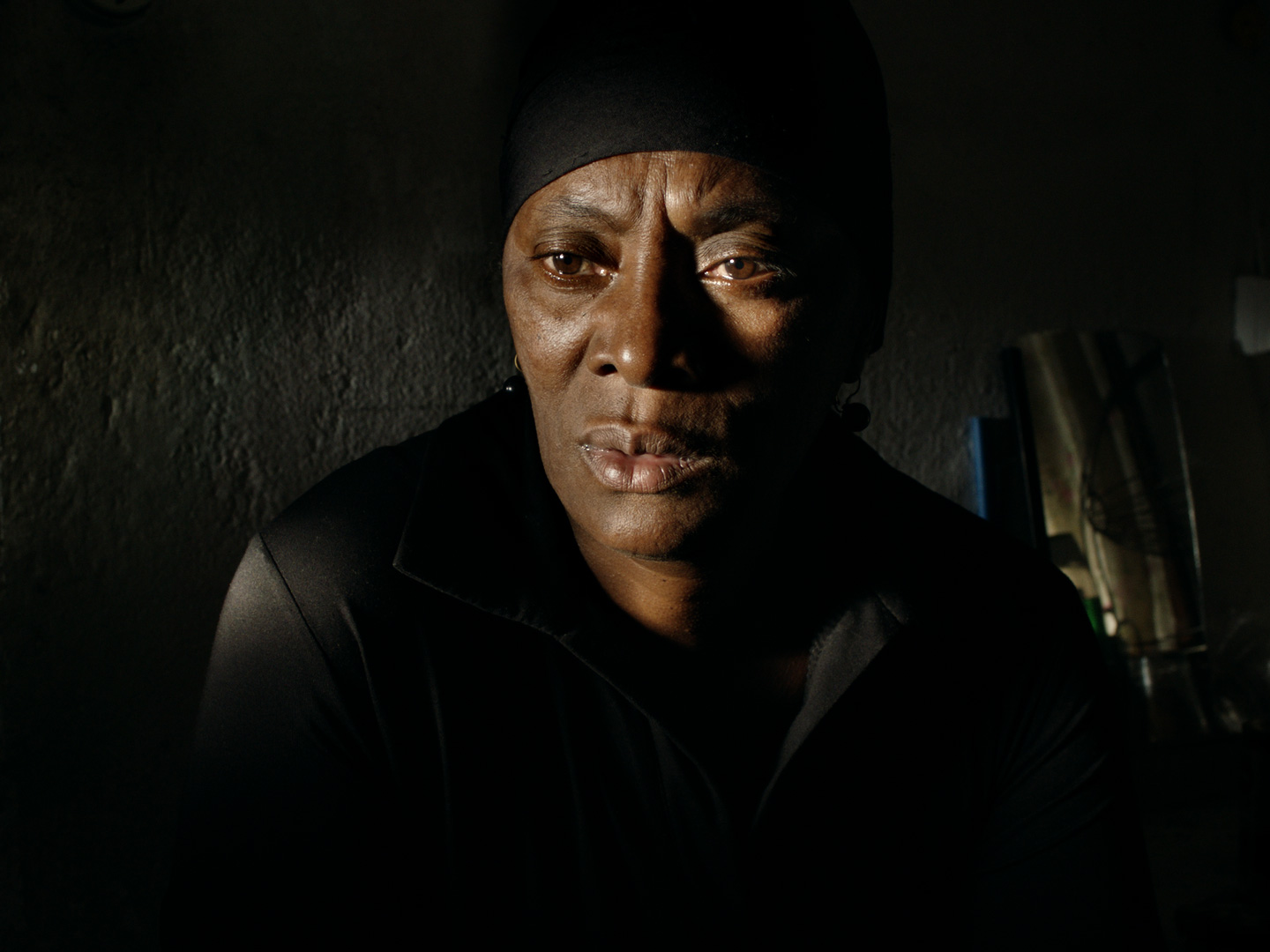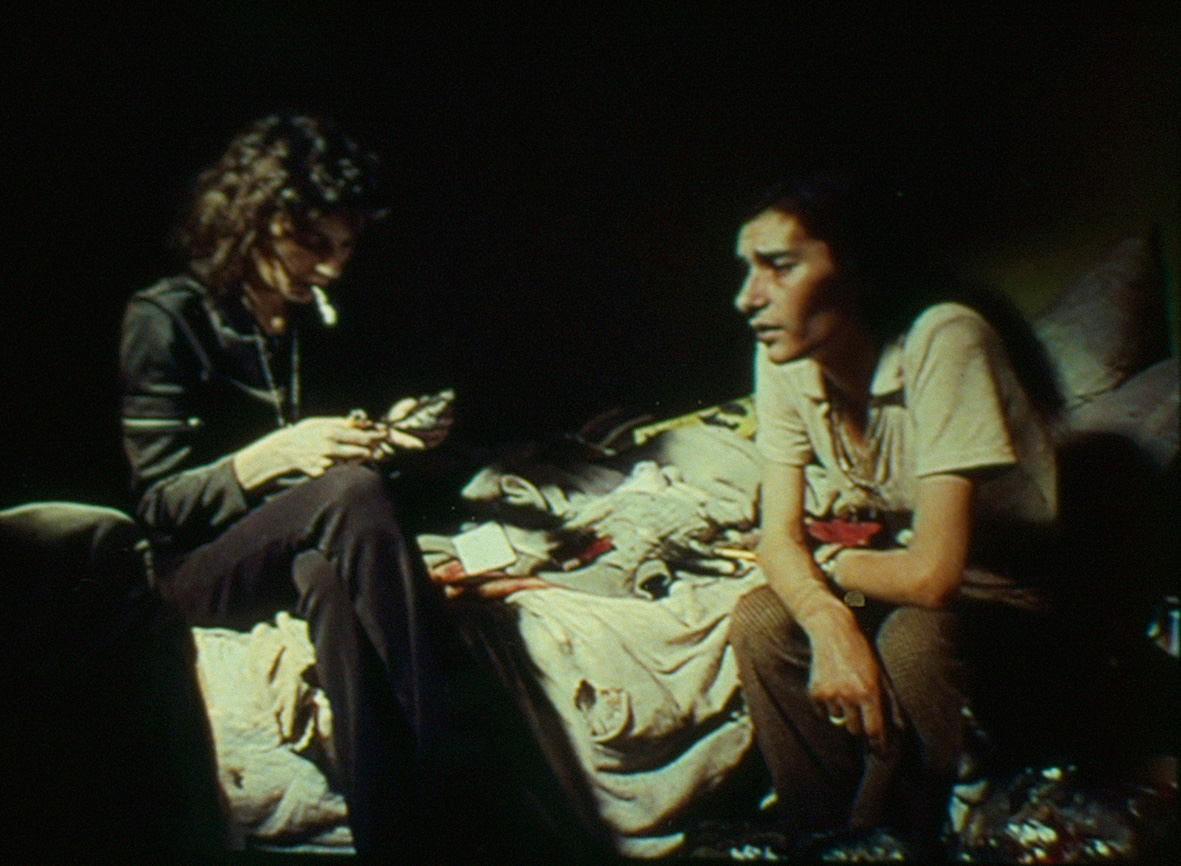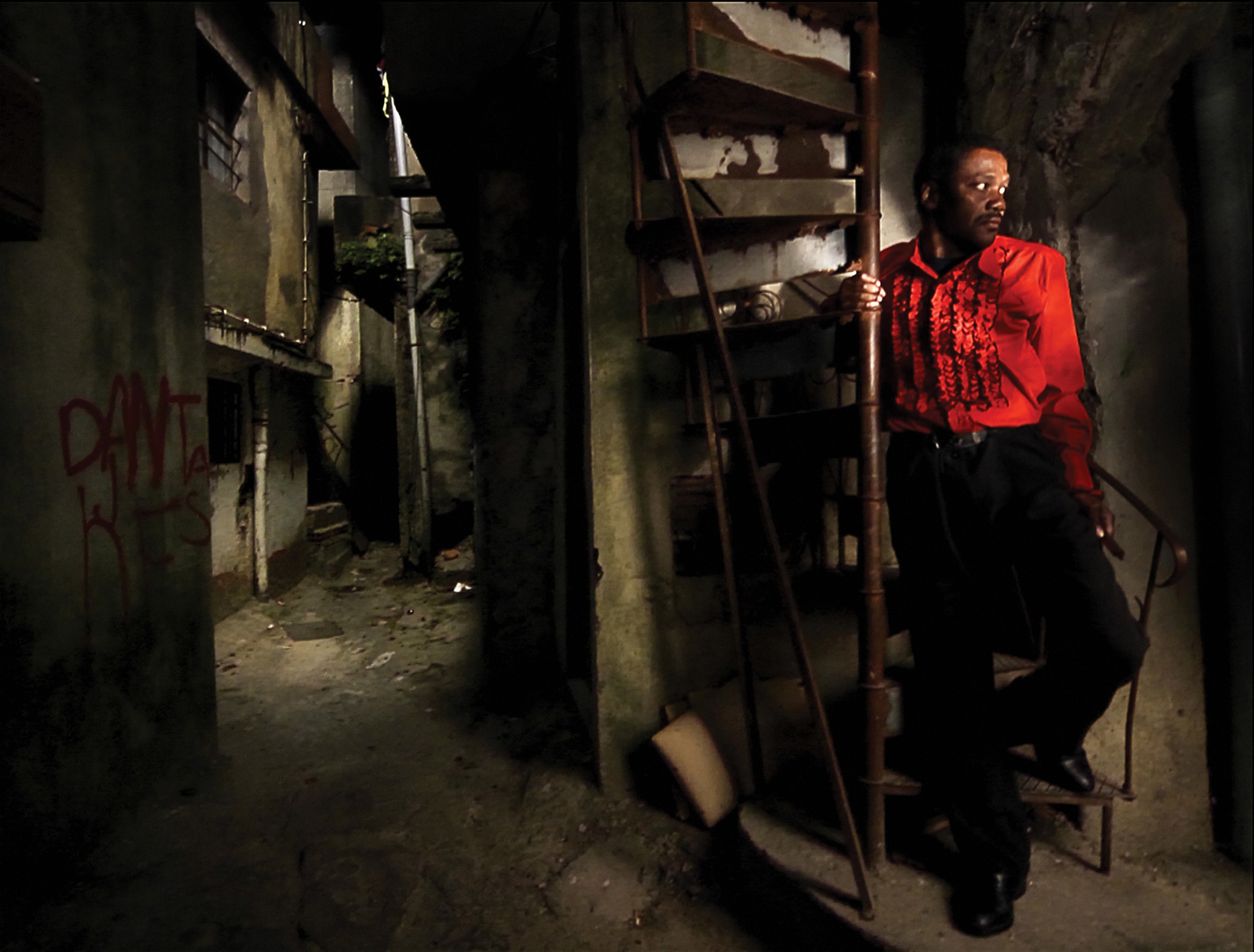Pedro Costa’s latest film takes as its title the name of its lead actor and protagonist, but for the first ten minutes, she’s nowhere to be seen. Instead, Vitalina Varela begins with a spectral procession of men filing out at night from a cemetery. The image is nearly drained of color, so dark that you might wonder for a moment whether that really is a metal cane swinging out of the blackness, or just a phantom movement swimming in the dim theater. The men shuffle and slouch, nodding and silent. Who are these people? Are they coming back from a burial, or retiring to their own graves after a night’s haunting?
The characters in Costa’s films resist easy comprehension. “Characters” may not even be precisely the right word for them. The director has spent most of his career exploring the lives of dispossessed people, many of them Cabo Verdean immigrants, living on the margins of Lisbon. For the past two decades, he has worked entirely with nonprofessional actors, shaping his films around the experiences of his collaborators—lives afflicted with addiction, poverty, displacement, criminalization, and violence. But Costa does not make documentaries. An exacting formalist, he creates films that are unmistakably rehearsed, staged, framed, lit, and paced to the measure of his sensibility. And the brittle and demanding poetry of his films testifies to the very real, often unfathomably difficult histories of the people onscreen.
It takes another twenty minutes for the woman who gives Vitalina Varela its name and the film its tragic heroine to speak. She arrives in Lisbon from Cabo Verde, a former Portuguese colony off the West African coast, to see her dying husband. In a vividly stylized entrance, she descends barefoot from an airplane, the only passenger in sight. On the tarmac, a crew of janitorial workers greets her; one woman embraces her and whispers the news that her husband is already dead and buried, adding, “Here in Portugal there is nothing for you. His house is not yours. Go back home.”
Heedless, Vitalina goes to her husband’s house. It’s clear from the tentative way she steps through its dark rooms that this is her first time here. Entering the bedroom, she bumps her head on the lintel and clutches her brow; as her hand slips down to caress the wall, Costa reveals her face for the first time, caught in a grimace of pain. She enters the room and, in a long, unbroken shot, sits by the bed. Turning to face herself in the mirror, taking off her earrings, and changing the wrap on her hair, she readies herself for a private wake. In this unfamiliar house, in a country she’s never set foot in before, Vitalina sets about mourning a man she hasn’t seen in years.
Costa met Varela soon after she arrived in Lisbon. While scouting locations for his previous film, Horse Money (2014), he was led to that very house by a local who thought it had been left empty after its occupant’s death. Intrigued by Varela, whom he found living there, he offered her a part in Horse Money, in which she recounts her story of coming to Portugal, delayed by bureaucracy, too late to see her husband, Joaquim.
This continuity between Vitalina Varela and its predecessor is typical of Costa’s approach; nearly every one of his films is a sequel or response to one previous. The chain of linkages that led to Vitalina Varela goes back at least as far as his second feature, Casa de Lava (1994), filmed in Cabo Verde. An elliptical meditation on the legacy of Portuguese colonialism, that film brought the director into contact with islanders whose relatives had emigrated to Portugal in search of jobs. He returned home carrying letters and packages for those exiles, many of them now living in a slum called Fontainhas outside of Lisbon. Costa resolved to make his next film there, filling out his cast with locals.
Ossos (1997) revolves around an indigent young father’s desperate quest to sell his newborn baby. Intoxicated with the visual possibilities of the neighborhood, Costa lets his camera linger on doorways and windows, porous walls through which people appear and vanish, emphasizing the lack of distinctions between indoor and outdoor space. This squalid world seems to operate according to its own obscure social laws, shaped by forces that hover just outside the frame (drugs, for instance are nowhere visible). Every cut shifts the drama’s center of gravity and every shot feels incomprehensible on its own; everything Costa shows us directs our attention to something undisclosed.
By making Ossos in Fontainhas, Costa had disrupted the life of the neighborhood. The social hierarchies of the film set, along with the heavy artillery of the filmmaking apparatus—lights, equipment, trucks—made him feel as if he were staging “a police raid or a military occupation.” He began returning to the neighborhood with a miniDV camera—at a time when digital feature-filmmaking was practically unheard of—and spent nearly two years filming Vanda Duarte, whom Costa had already cast in Ossos, and her family and neighbors.
Advertisement
In Vanda’s Room (2000) finds Vanda smoking heroin in her bedroom, sitting crouched over a folded sheet of tin foil. In Ossos, Costa had tamped her performance down to a steely, confrontational posture, emphasizing her heavy-browed, androgynous beauty. Here she is voluble and constantly coughing, dispensing advice to the neighbors who come to visit, arguing with her sister, and rising from her bed only to make her rounds selling vegetables. Describing the cramped labyrinth in which he shot the film, Costa later said, “There was no inside and outside, every street was a hallway, every house was a street, every bedroom was a public square. That’s why I wanted to film with Vanda in her bedroom, because her bedroom was practically like a public forum.”
Where another outsider might have seen only dereliction and despair, Costa discovered a multiethnic society that found space for both conflict and cooperation between its citizens. At the time Costa was filming, though, this community was being torn apart, its ramshackle homes leveled by demolition crews sent to clear the slums. The rumble and crash of excavators are a near-constant presence on the soundtrack of In Vanda’s Room.
An audiovisual record of Fontainhas’s final days, the film could easily be mistaken for a vérité documentary. And yet the conversations and gestures of the people on screen are thoroughly rehearsed and shaped by Costa’s direction. After observing Vanda and company for an extended period, Costa would ask them to repeat a months-old conversation for the camera, or to improvise on a theme that he had heard them speak about before. Then the scene would be reworked, repeated, and refilmed until Costa felt that it was executed with precision.
By the time Costa made Colossal Youth (2006), most of Fontainhas’s residents had been scattered and relocated to public housing. The film connects them through Ventura, a Cabo Verdean immigrant of regal bearing and frayed sanity, who passes from home to home visiting the doubly dislocated men and women he refers to as his children. By these theatrical means, Costa organizes a community that no longer exists as such. A sober Vanda reappears, avowedly clean and shockingly older, but the focus has shifted, through Ventura, to a previous generation.
The film’s Portuguese title, Juventud em marcha, or “Youth on the March,” sounds an ironic echo of the revolutionary ferment in which Costa came of age. When he was a young teenager, the 1974 leftist military rebellion that overthrew the Estado Novo dictatorship and the period of social upheaval that followed allowed him to “discover and experience politics, music, films, girls, all at the same time.” Thirty years later, he looked back on this jubilation critically, troubled by the revolution’s failures. Portugal may have relinquished its African colonies and joined democratic Europe, but the subjects of its long imperial history still experienced arbitrary forced relocation, buffeted from place to place by waves of job scarcity, immigration law, and slum clearance.
In interviews, Costa has often professed a surprising aim: revenge. Specifically, he hopes that his films “will avenge all the bad stories that were told in film and books about the Portuguese revolution.” Nowhere is this clearer than in Horse Money, a phantasmagoric sequel to Colossal Youth that seems to play out entirely within the corridors of Ventura’s mind. Set largely in a succession of dingy institutional chambers—part hospital, part prison—the film collapses the past into the present, as Ventura relives the traumas he experienced at the time of the revolution. While a young Costa was rejoicing, Ventura was terrified by the sudden appearance in the streets of the soldiers who, up until then, had been an occupying force in the colony he came from. It’s here that Varela entered Costa’s cinema, providing a counterpoint to Ventura’s feverish isolation by evoking the complementary sorrows of those who stayed behind in Cabo Verde.
Costa’s recent films divulge their meanings reluctantly, preferring to confront viewers with a richly opaque surface. His formal approach draws on an eclectic range of influences: the slum photography of Jacob Riis; the muted performances elicited by Robert Bresson; the Brechtian stringency of Jean-Marie Straub and Danièle Huillet; the DIY star system of Andy Warhol’s Screen Tests; António Reis and Margarida Cordeiro’s mixture of ethnography and fiction; Howard Hawks’s attention to gesture; Jacques Tourneur’s chiaroscuro imagery.
Advertisement
More than any other films I can think of, Costa’s seem to aspire to stillness—the people move, but the camera rarely does. Psychology and narrative momentum are all but banished, leaving images in which the performers confront us with sheer presence. In this sense, Costa’s cinema is a form of portraiture, an unwavering look at people whom cameras rarely study. In order to keep his gaze steady, Costa refuses to treat the people he films as puzzles waiting to be solved. “Ventura or Vanda will often tell me, ‘I don’t believe for a second that you could know me, that you could know what I’ve lived through.’ And I respond, ‘of course.’”
In Vitalina Varela, Costa doesn’t attempt to answer the obvious question about the woman he’s filming: Why does she stay in Portugal rather than return home to Cabo Verde? Toward the end of In Vanda’s Room, one of Vanda’s junkie neighbors delivers a devastating confession, lamenting a life spent squatting in “ghost houses other people left empty.” Vitalina is no better pleased by the slum quarters her husband lived in, reprimanding him for the “poorly done job” in one of several monologues addressed to the dead man. She measures it against the house they built together in Cabo Verde and curses him for leaving her alone when he abruptly returned to Portugal. “Couldn’t you have fixed this roof?” she asks later, when a storm pounds above her and rainwater leaks into the house. “You know how scared I am.”
These reproaches and entreaties seem to tie her yet closer to the place, even as it fills her with bitterness. The Cabo Verdean men who marched home from the cemetery at the outset of the film, we learn, were friends of Joaquim’s. They visit Vitalina to pay her their respects, but she receives them with rancor. Having left Cabo Verde and other women like her behind, their failings are Joaquim’s, too—she accuses them of drunkenness, sloth, and womanizing, vices bred by the cruelties of life in exile. They overstay their welcome and make unwanted visits at night, as if haunting the house in their fallen companion’s name. In this they resemble the ghosts of Mati Diop’s 2019 Atlantics, Senegalese men who possess the women they loved after drowning at sea while attempting to reach Europe. But where that film united fallen men and living women with a righteous if tragic purpose, Joaquim’s spirit seems only to inflame Vitalina’s spite.
Apart from Joaquim’s friends stands Ventura, here playing a destitute priest. His exhausted gait and trembling hands, as well as the Beckettian fragments he incants as he walks (“I’ll go, I’ll go… unsure, waiting…”) are in keeping with his persona from Horse Money, but his character is drawn from a story that Varela told Costa about a disgraced priest, his church an empty shack with a corrugated metal pediment and rows of desk chairs for pews. The stark perpendicular of the cross appears again and again—in the telephone poles Costa cuts away to, in the crucifix Vitalina places between candles in a modest shrine—something new in Costa’s films, which hadn’t previously invoked the visual lexicon of Christianity. Varela’s faith gives Costa a new set of images to work with, and lends her suffering a different frame from the one that surrounded Vanda or Ventura in the earlier films. Her pain is both deeper and more directly confronted; her belief gives her a context in which to understand it.
Faced with the asphyxiating darkness that sets in from the very first scene, some viewers may revolt, much as the critic David Thomson objected to Abbas Kiarostami’s Taste of Cherry: “If this is modern movie mastery, then our medium is gone and this is funerary art.” It can be tempting to see Costa’s cinema as somehow terminal, and his embrace of digital techniques has coincided with the slow demise of 35mm shooting and projection. Yet time has proven unkind to Thomson’s judgment on Kiarostami, and his sentence came with a dollop of cloying paternalism: he conceded that Iran “may be regaining its imagination,” but concluded that Kiarostami had arrived late to a modernism that “Godard and many others” (presumably Europeans) had already claimed as their own.
Perhaps it’s Europe that needs to regain its imagination. In light of migration crises and a resurgent far right, a growing number of filmmakers have struck an oppositional pose, issuing salvos against a fortress-minded West intent on shutting out refugees from the regions its colonial armies once trampled. The strongest films in this vein, such as Christian Petzold’s Transit (2018) and Alice Rohrwacher’s Happy as Lazzaro (2018), tend to look inward, re-enacting Europe’s internal conflicts from the twentieth century in the present day, with dark-skinned characters looking on from the margins. Most attempts to serve immigrant stories over reheated humanism are less successful, like Aki Kaurismäki’s sentimental fables Le Havre (2011) and The Other Side of Hope (2017). Some talents seem sheepishly inhibited by the task: the usually provocative Bertrand Bonello’s Haitian nocturne Zombi Child (2019) looks timid and self-conscious next to Costa’s Casa de lava, which similarly takes inspiration from Jacques Tourneur’s B-movie classic I Walked with a Zombie (1943).
Costa’s position is not ethically impregnable. Some might wonder why he doesn’t make his working methods more democratic still and renounce his auteur status altogether, letting Varela and Ventura co-direct his films. Others might ask whether his focus on the small-scale politics of slum life are really just a guise of left-wing defeatism that has given up on the promise of revolutionary change that thrilled him in his youth. But Costa has not merely sought, as plenty of other filmmakers have, to tell different kinds of stories; he’s also rebuilt his method from the ground up in order to earn the trust of the people he works with. What’s more, his exacting formalism clearly makes heavy demands on his actors, and the dense beauty of the images they’ve created together suggests that the trust is mutual.
Costa’s earlier films have shown how his country’s history has left Cabo Verdeans wounded in ways that even he still struggles to understand. Vitalina Varela emphasizes that, even among the people connected by this collective experience, a gendered chasm yawns wide. Men have flocked to Portugal for work, while many of the women they once loved have stayed behind. This divide between the masculine sphere of hard metropolitan labor and the feminized motherland breeds fierce antagonisms. In one scene, Vitalina lets her fury toward her husband and his friends lash out at Ventura, accusing him of taking the men’s side: “When you see a woman’s face in the coffin, you can’t imagine her suffering.”
An enmity this deep seems irreparable within a world as drawn to stasis as Costa’s. Yet the film ends on a note of hope, even a kind of resurrection. Vitalina hears a heavy thumping above her house, and steps outside to find her fallen husband’s comrades repairing the leaky roof. This small gesture of everyday solidarity—the only kind that Costa now trusts—triggers a final flashback, a gorgeous image of Vitalina and Joaquim building their house beneath a blazing island sun. It has the cadence of a reconciliation, even as it takes Vitalina back to a vanished past.
Pedro Costa’s Vitalina Varela is now playing at New York City’s Film at Lincoln Center. Ossos (1997), In Vanda’s Room (2000), and Colossal Youth (2006) are available from Criterion Collection.







